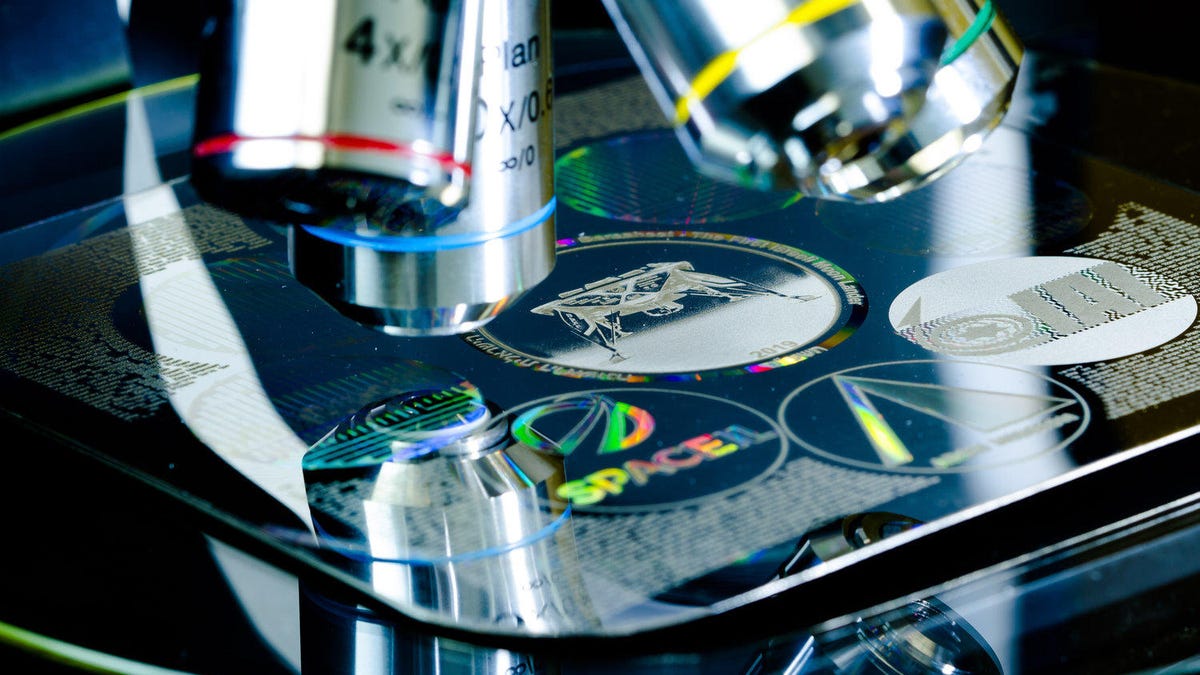Thirty-million-page backup of humanity headed to moon aboard Israeli lander
If the apocalypse strikes, the Arch Mission Foundation wants to be sure all the knowledge we've accumulated doesn't disappear.

The top layers of the archive disc can be viewed with an optical microscope.
On Thursday night, a SpaceX Falcon 9 rocket carried an Israeli-made spacecraft named Beresheet beyond the grasp of Earth's gravity and sent it on its way to the surface of the moon. On board Beresheet is a specially designed disc encoded with a 30-million-page archive of human civilization built to last billions of years into the future.
The backup for humanity has been dubbed "The Lunar Library" by its creator, the Arch Mission Foundation (AMF).
"The idea is to place enough backups in enough places around the solar system, on an ongoing basis, that our precious knowledge and biological heritage can never be lost," the nonprofit's co-founder Nova Spivack told me via email.
The AMF also placed a small test archive on Elon Musk's red Tesla Roadster that was launched in the direction of Mars aboard the first Falcon Heavy demonstration mission last year. That archive consisted of Isaac Asimov's Foundation Trilogy encoded in a disc made of quartz silica glass made to last millions of years as the Roadster orbits the sun. The AMF has also placed a solid-state copy of Wikipedia on board a cubesat from SpaceChain in low-Earth orbit.
The little lander Beresheet hopes to make history in multiple ways this year.
Part of the motivation for the far-out project is to leave a copy of humanity's knowledge not just in the cloud, but far beyond the clouds, should the impacts of climate change or a potential nuclear war do us or the planet in at some point in the future.
"While I am optimistic that humanity will rise to the challenge and develop a multinational planetary defense initiative to mitigate these planetary risks, it is also prudent to have a plan B," Spivack said. "Instead of one backup in one place our strategy is 'many copies, many places' -- and we plan to send updates on a regular basis."
The AMF has already signed on to an additional planned moon mission, with startup Astrobotic, to send another Lunar Library installment to the moon in the next few years. There are also plans in the works to send archives to Mars, LaGrange points around Earth and deep underground caves on our planet.
"The interplanetary network of backup locations we have started may even help to enable an interplanetary Internet. As we become a spacefaring civilization, we are going to need ways to move big data around the solar system, and protect it in transit, and at each location," Spivack said.
The disc aboard Beresheet is about the size and thickness of a DVD, but consists of 25 stacked thin nickel films that AMF insists can resist radiation, extreme temperatures and other harsh conditions found in space for billions of years. There is, of course, no way to test how long it will last, but if it survives as long as hoped, the disc may even be around longer than the moon itself.
The top four layers are actually filled with 60,000 pages of tiny analog images that can be viewed with optical microscope technology that's been around for centuries. The images include a sort of users' guide explaining human language, the contents of the disc and how to access the deeper layers containing compressed digital data.
The digitized layers include a full copy of Wikipedia, more than 25,000 books and data for understanding over 5,000 languages.
But if humans -- or perhaps someone else -- is ever going to get a chance to use the Lunar Library, it has to first get to the surface of the moon. Beresheet is now just beginning a long, complicated journey that will involve a handful of swings around Earth to increase the size of its orbit before jumping into orbit around the moon and eventually attempting a landing.
The first window of opportunity to land comes on April 11. So if all works out, Wikipedia will touch down on the moon almost exactly 50 years after man first showed up there. Any aliens who come across it in the future will surely be baffled by a few choice entries, like "moon-landing conspiracy theories," "flat Earth" or "Tide pod challenge." But at least they'll help illustrate why we needed a backup.

